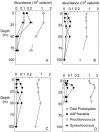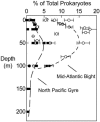Aerobic anoxygenic phototrophic bacteria in the Mid-Atlantic Bight and the North Pacific Gyre
- PMID: 16391092
- PMCID: PMC1352302
- DOI: 10.1128/AEM.72.1.557-564.2006
Aerobic anoxygenic phototrophic bacteria in the Mid-Atlantic Bight and the North Pacific Gyre
Abstract
The abundance of aerobic anoxygenic phototrophic (AAP) bacteria, cyanobacteria, and heterotrophs was examined in the Mid-Atlantic Bight and the central North Pacific Gyre using infrared fluorescence microscopy coupled with image analysis and flow cytometry. AAP bacteria comprised 5% to 16% of total prokaryotes in the Atlantic Ocean but only 5% or less in the Pacific Ocean. In the Atlantic, AAP bacterial abundance was as much as 2-fold higher than that of Prochlorococcus spp. and 10-fold higher than that of Synechococcus spp. In contrast, Prochlorococcus spp. outnumbered AAP bacteria 5- to 50-fold in the Pacific. In both oceans, subsurface abundance maxima occurred within the photic zone, and AAP bacteria were least abundant below the 1% light depth. The abundance of AAP bacteria rivaled some groups of strictly heterotrophic bacteria and was often higher than the abundance of known AAP bacterial genera (Erythrobacter and Roseobacter spp.). Concentrations of bacteriochlorophyll a (BChl a) were low ( approximately 1%) compared to those of chlorophyll a in the North Atlantic. Although the BChl a content of AAP bacteria per cell was typically 20- to 250-fold lower than the divinyl-chlorophyll a content of Prochlorococcus, the pigment content of AAP bacteria approached that of Prochlorococcus in shelf break water. Our results suggest that AAP bacteria can be quite abundant in some oceanic regimes and that their distribution in the water column is consistent with phototrophy.
Figures




Similar articles
-
High abundances of aerobic anoxygenic photosynthetic bacteria in the South Pacific Ocean.Appl Environ Microbiol. 2007 Jul;73(13):4198-205. doi: 10.1128/AEM.02652-06. Epub 2007 May 11. Appl Environ Microbiol. 2007. PMID: 17496136 Free PMC article.
-
Bacteriochlorophyll and community structure of aerobic anoxygenic phototrophic bacteria in a particle-rich estuary.ISME J. 2010 Jul;4(7):945-54. doi: 10.1038/ismej.2010.13. Epub 2010 Feb 25. ISME J. 2010. PMID: 20182527
-
Contribution of aerobic photoheterotrophic bacteria to the carbon cycle in the ocean.Science. 2001 Jun 29;292(5526):2492-5. doi: 10.1126/science.1059707. Science. 2001. PMID: 11431568
-
Bioenergetics of photoheterotrophic bacteria in the oceans.Environ Microbiol Rep. 2013 Apr;5(2):188-99. doi: 10.1111/j.1758-2229.2012.00367.x. Epub 2012 Jul 24. Environ Microbiol Rep. 2013. PMID: 23584962 Review.
-
Ecology of aerobic anoxygenic phototrophs in aquatic environments.FEMS Microbiol Rev. 2015 Nov;39(6):854-70. doi: 10.1093/femsre/fuv032. Epub 2015 Jul 1. FEMS Microbiol Rev. 2015. PMID: 26139241 Review.
Cited by
-
Primary production in a subtropical stratified coastal lagoon--contribution of anoxygenic phototrophic bacteria.Microb Ecol. 2011 Jan;61(1):223-37. doi: 10.1007/s00248-010-9739-x. Epub 2010 Sep 1. Microb Ecol. 2011. PMID: 20809289
-
Comparison of growth rates of aerobic anoxygenic phototrophic bacteria and other bacterioplankton groups in coastal Mediterranean waters.Appl Environ Microbiol. 2011 Nov;77(21):7451-8. doi: 10.1128/AEM.00208-11. Epub 2011 Jul 1. Appl Environ Microbiol. 2011. PMID: 21724878 Free PMC article.
-
Metagenomes, Metatranscriptomes, and Metagenome-Assembled Genomes from Chesapeake and Delaware Bay (USA) Water Samples.Microbiol Resour Announc. 2021 May 27;10(21):e0026221. doi: 10.1128/MRA.00262-21. Epub 2021 May 27. Microbiol Resour Announc. 2021. PMID: 34042480 Free PMC article.
-
The variability of light-harvesting complexes in aerobic anoxygenic phototrophs.Photosynth Res. 2016 Apr;128(1):35-43. doi: 10.1007/s11120-015-0197-7. Epub 2015 Oct 19. Photosynth Res. 2016. PMID: 26482589
-
Photoheterotrophic microbes in the Arctic Ocean in summer and winter.Appl Environ Microbiol. 2009 Aug;75(15):4958-66. doi: 10.1128/AEM.00117-09. Epub 2009 Jun 5. Appl Environ Microbiol. 2009. PMID: 19502441 Free PMC article.
References
-
- Beja, O., E. N. Spudich, J. L. Spudich, M. Leclerc, and E. F. DeLong. 2001. Proteorhodopsin phototrophy in the ocean. Nature 411:786-789. - PubMed
-
- Beja, O., M. T. Suzuki, J. F. Heidelberg, W. C. Nelson, C. M. Preston, T. Hamada, J. A. Eisen, C. M. Fraser, and E. F. DeLong. 2002. Unsuspected diversity among marine aerobic anoxygenic phototrophs. Nature 415:630-633. - PubMed
-
- Billen, G., P. Servais, and S. Becquevort. 1990. Dynamics of bacterioplankton in oligotrophic and eutrophic aquatic environments—bottom-up or top-down control. Hydrobiologia 207:37-42.
-
- Campbell, L. 2001. Flow cytometric analysis of autotrophic picoplankton, p. 317-343. In J. H. Paul (ed.), Methods in microbiology, vol. 30. Academic Press, San Diego, Calif.
Publication types
MeSH terms
Substances
LinkOut - more resources
Full Text Sources
Other Literature Sources
Molecular Biology Databases
Miscellaneous

